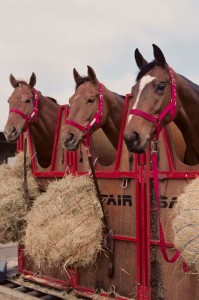Energy and Protein Levels of Hay
Do you know the energy and protein levels of your hay? What about the energy and protein requirements of your horse based on their type, condition, and workload?
The energy and protein content of hay depends on what type of hay it is. Hays are categorized into two different types; grass hays and legume hays.
Grass Hays
Compared to legume hay, grass hays have:
o More fiber (due to increased stalks)
o Less protein
o Fewer calories per pound
- Commonly Used For:
o “Easy Keepers”
o Horses doing little/no work
- Common Examples of Grass Hays:
o Timothy, brome grass, orchard grass, Coastal Bermuda, and oat hay.
à Protein & Energy Levels of Grass Hays:
| Energy Content (Mcal/lb) | Crude Protein (%) | |
| Grass hay cool season, immature | 15.1% | .9 |
| Grass hay cool season, mid-mature | 11.1% | .83 |
| Grass hay cool season, mature | 9.1% | .78 |
Legume Hays
Compared to grass hays, legume hays have:
o Less fiber
o More protein
o More calories per pound
o Higher calcium to phosphorous ratio
Legume hays have more protein because they have the ability to store nitrogen in specialized roots called nodules. Yet the protein level of both legume and grass hays depends on its maturity level.
- Commonly Used For:
o Lactating Mares
o Growing Horses
o Horses doing intense work
- Common Examples of Grass Hays:
o Alfalfa, clover, and birdsfoot trefoil
à Protein & Energy Levels of Legume Hays:
| Energy Content (Mcal/lb) | Crude Protein (%) | |
| Legume hay, immature | 17.3% | 1.0 |
| Legume hay, mid-mature | 17.5% | .92 |
| Legume hay, mature | 14.9% | .84 |
To more easily compare the hay’s content to the horse’s requirements, here are a few scenarios.
- A mature horse with intense workload requires 1.3 Mcal/lb of energy and 11.4% of crude protein. By using the above charts, it can be concluded that this horse would most likely be fed legume hays.
- An aged pony that is retired requires .1 Mcal/lb of energy and 10.2% crude protein would most likely be fed grass hay.
- A growing weanling that needed 1.4 Mcal/lb of energy and 14.5% of crude protein would probably be fed legume hay.
These scenarios do not include the vitamins, minerals, and ratios required to make accurate decisions about the type of hay to specifically feed. It is always recommended to consult your vet.
-
Articles
- April 2024
- March 2024
- February 2024
- January 2024
- December 2023
- November 2023
- October 2023
- September 2023
- August 2023
- July 2023
- June 2023
- May 2023
- April 2023
- March 2023
- February 2023
- December 2022
- November 2022
- October 2022
- September 2022
- August 2022
- July 2022
- June 2022
- May 2022
- April 2022
- March 2022
- February 2022
- January 2022
- December 2021
- November 2021
- October 2021
- September 2021
- August 2021
- July 2021
- May 2021
- April 2021
- March 2021
- February 2021
- January 2021
- December 2020
- November 2020
- October 2020
- September 2020
- August 2020
- July 2020
- June 2020
- May 2020
- April 2020
- March 2020
- February 2020
- January 2020
- December 2019
- November 2019
- October 2019
- September 2019
- August 2019
- July 2019
- June 2019
- May 2019
- April 2019
- March 2019
- February 2019
- January 2019
- December 2018
- November 2018
- October 2018
- September 2018
- August 2018
- July 2018
- June 2018
- May 2018
- April 2018
- March 2018
- February 2018
- January 2018
- November 2017
- October 2017
- September 2017
- August 2017
- July 2017
- June 2017
- May 2017
- April 2017
- March 2017
- February 2017
- January 2017
- December 2016
- October 2016
- September 2016
- August 2016
- July 2016
- June 2016
- May 2016
- April 2016
- March 2016
- February 2016
- January 2016
- December 2015
- November 2015
- October 2015
- August 2015
- June 2015
- May 2015
- March 2015
- November 2014
- March 2014
- October 2013
- September 2013
- August 2013
- January 2013
- December 2012
- November 2012
- October 2012
- September 2012
- January 2012
- October 2011
- September 2011
- August 2011
- July 2011
- June 2011
- February 2011
-
Meta






